Overwatch review
The team that fights together...
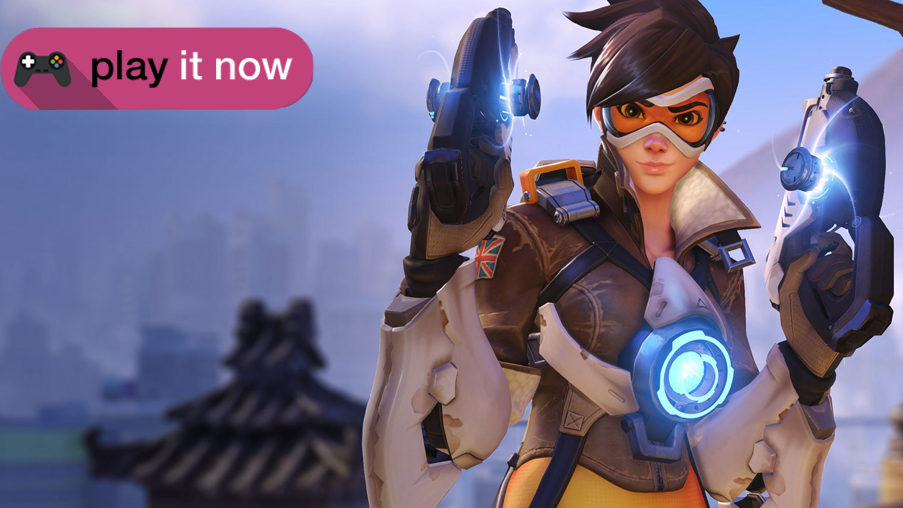
Overwatch is a game of balance and imbalance.Though this team combat game draws on the classic tank-healer-DPS triad of MMOGs like World of Warcraft, the characters you actually play are wildly different - so different that every button you press changes function between characters.
The same button that causes one character to run might cause another to grapple, another to teleport, another to shield and so on. Even characters ostensibly of the same type - such as snipers like Widowmaker and Hanzo - are utterly different in their mechanics and movement.
In that sense it's very much the spiritual successor to 2007's Team Fortress 2 and a competitor to the recently-released Battleborn.
The game is a classic team arena shooter, with two six-person teams of outrageous humanoids battling throughout a bright, science-fiction future for a set of very simple objectives - escorting a slow-moving car, capturing and holding a point, or just killing the other team.
Every match is simple and short, and feeds straight into the next.
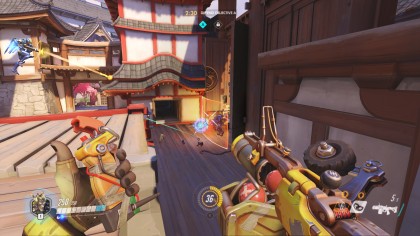
The Super Best Friends
Like Team Fortress 2, Overwatch has a selection of characters to deal with rather than just classes. Each character fulfils different roles on the battlefield, though they share elements with other similar classes.
All the tanks, for example, have high hit points - but where Zarya moves slowly and her short-lived shield converts incoming fire into additional damage for her beam weapon, D-va has a giant flying mech to ride in / self-destruct; Winston is a giant educated gorilla who can leap large distances and has an auto-aiming particle beam; and Reinhardt has an energy shield and giant hammer.
Sign up for breaking news, reviews, opinion, top tech deals, and more.
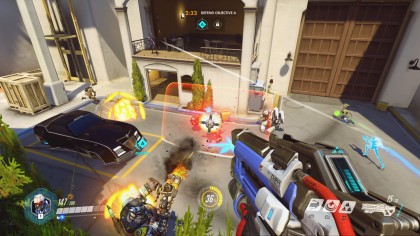
Crucially, all the characters are light. They're jovial. Their attitude isn't about a fight to the death, they're off to play volleyball or have a few beers. They all have bright, iconic designs, with careful silhouetting to show who they are and silly voices to make sure you understand; this isn't serious.
This isn't an attempt at world-building. This doesn't have a rich, worthy narrative. This is bright, light fun.
With 21 of these cartoon characters at launch (and more to come), Overwatch definitely has a good starting variety. Unlike Battleborn, the characters are all available to play straight away and nothing requires unlocking as you play.
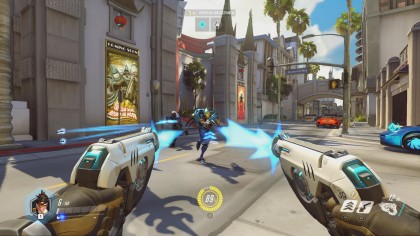
There's no equipment screen where you need to organise a hundred stats - a single button press tells you all their abilities. They also start with all their abilities unlocked during each match, and can't be customised, so everyone is playing with the same characters. It's back to basics all-round.
And, indeed, everyone can play with the same characters. You can have a team with six Tracers or one composed entirely of tanks, but do so and the game will warn you away - and you'll (probably) lose. Handholding such as this subtly works to improve the experience for everyone by ensuring that you always have a balanced team.
That's not always paid attention to though. Many of the games I've played, I've been the only player willing to switch, while the inevitable gamers who only play as Reaper have ignored the warnings and lost us the match.
It's frustrating, but something that disappears the more you play - and down to the players, not Blizzard.
The Team That Fights Together
The reason that you'll lose is that no character is a match-winner by himself or herself. All of their weapons are perfectly unbalanced, meaning that they're only really good in certain situations. Junkrat's grenades are best bouncing round corners, but he's in trouble when he's face-to-face with Reinhart's hammer.
Reinhart's energy shield might be great at defending him and his team from the front, but it only takes Pharah to fly above him and rain down rockets, and he's got no answer. And Pharah might be queen of the skies, but Widowmaker can take her down with one shot from halfway across the map. They all have their own vulnerabilities and specialities.
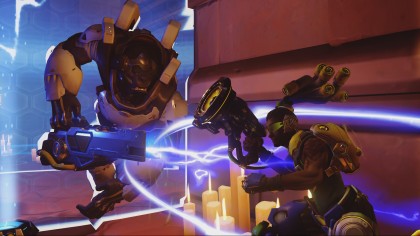
That means it really is a game about working together - about using someone else's strength to cover your weakness, like a Viking shield wall. It's about using Symmetra's teleporter to get Zarya back to the front line because otherwise she's so damn slow. About Winston shielding Bastion as he rides on top of the payload in his turret mode, as he dies so damn fast otherwise. About dropping Zenyatta's invulnerability and healing Ultimate at just the right moment to draw fire and heal everyone up for one big push.
The twelve maps themselves are extremely straightforward too - small, tight and linear - and feel like instant classics. Every side route, every high path, every tunnel, leads you back to the main fight, feeds into the main objective.
You'll rarely be fighting alone here or wasting time wandering corridors. The look of each map matches that quality, without ever distracting from your goal.
With objectives that can be completed quickly, you can play an entire game in ten minutes. And as you can change to any character at any point in the game (at the cost of resetting your ultimate charge), you need to be spotting enemy vulnerabilities and switching them out fast.
- Check out our picks of the best PS4 games